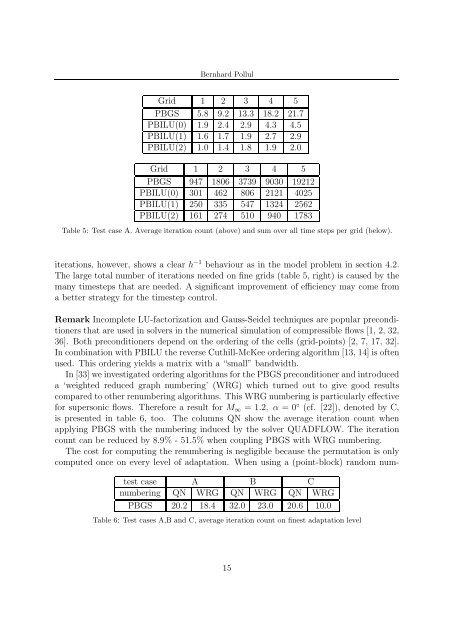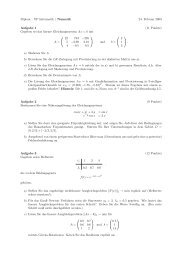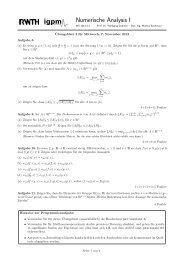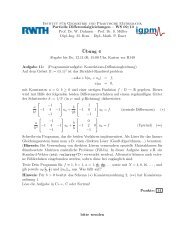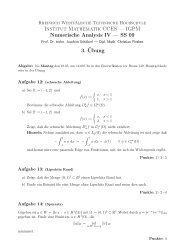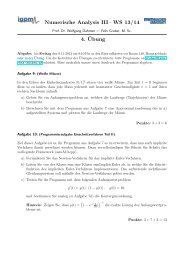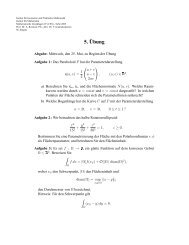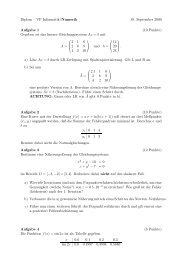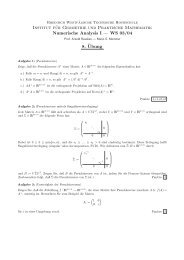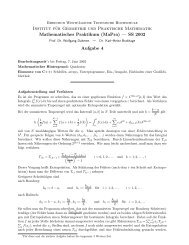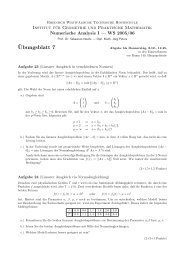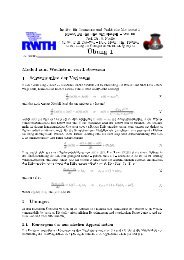preconditioners for linearized discrete compressible euler equations
preconditioners for linearized discrete compressible euler equations
preconditioners for linearized discrete compressible euler equations
You also want an ePaper? Increase the reach of your titles
YUMPU automatically turns print PDFs into web optimized ePapers that Google loves.
Bernhard Pollul<br />
Grid 1 2 3 4 5<br />
PBGS 5.8 9.2 13.3 18.2 21.7<br />
PBILU(0) 1.9 2.4 2.9 4.3 4.5<br />
PBILU(1) 1.6 1.7 1.9 2.7 2.9<br />
PBILU(2) 1.0 1.4 1.8 1.9 2.0<br />
Grid 1 2 3 4 5<br />
PBGS 947 1806 3739 9030 19212<br />
PBILU(0) 301 462 806 2121 4025<br />
PBILU(1) 250 335 547 1324 2562<br />
PBILU(2) 161 274 510 940 1783<br />
Table 5: Test case A. Average iteration count (above) and sum over all time steps per grid (below).<br />
iterations, however, shows a clear h −1 behaviour as in the model problem in section 4.2.<br />
The large total number of iterations needed on fine grids (table 5, right) is caused by the<br />
many timesteps that are needed. A significant improvement of efficiency may come from<br />
a better strategy <strong>for</strong> the timestep control.<br />
Remark Incomplete LU-factorization and Gauss-Seidel techniques are popular <strong>preconditioners</strong><br />
that are used in solvers in the numerical simulation of <strong>compressible</strong> flows [1, 2, 32,<br />
36]. Both <strong>preconditioners</strong> depend on the ordering of the cells (grid-points) [2, 7, 17, 32].<br />
In combination with PBILU the reverse Cuthill-McKee ordering algorithm [13, 14] is often<br />
used. This ordering yields a matrix with a “small” bandwidth.<br />
In [33] we investigated ordering algorithms <strong>for</strong> the PBGS preconditioner and introduced<br />
a ‘weighted reduced graph numbering’ (WRG) which turned out to give good results<br />
compared to other renumbering algorithms. This WRG numbering is particularly effective<br />
<strong>for</strong> supersonic flows. There<strong>for</strong>e a result <strong>for</strong> M ∞ = 1.2, α = 0 ◦ (cf. [22]), denoted by C,<br />
is presented in table 6, too. The columns QN show the average iteration count when<br />
applying PBGS with the numbering induced by the solver QUADFLOW. The iteration<br />
count can be reduced by 8.9% - 51.5% when coupling PBGS with WRG numbering.<br />
The cost <strong>for</strong> computing the renumbering is negligible because the permutation is only<br />
computed once on every level of adaptation. When using a (point-block) random numtest<br />
case A B C<br />
numbering QN WRG QN WRG QN WRG<br />
PBGS 20.2 18.4 32.0 23.0 20.6 10.0<br />
Table 6: Test cases A,B and C, average iteration count on finest adaptation level<br />
15


